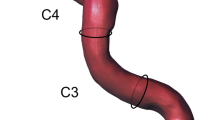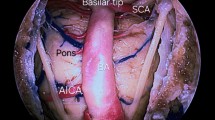Summary
The clinical characteristics of elderly patients with multiple intracranial aneurysms were studied. A total of 481 patients, in whom the exact location of their ruptured aneurysms could be confirmed, were classified into two age groups, that is, those aged 59 years or younger (group 1: 247 cases, 51%) and those aged 60 years or older (group 2: 234 cases, 49%). The incidences of multiple aneurysms were 30% for group 1 and 27% for group 2. This difference is statistically not significant. The rate of multiple aneurysms was less frequent in males than in females in group 2, whereas no difference could be found in group 1. The age distribution of patients with multiple aneurysms was basically similar to that of patients with single aneurysms. While the highest rupture rate was observed in the anterior communicating artery aneurysms of both groups, this tendency was more prominent in group 2(79%) than in group 1 (59%). The rupture rates for other sites in group 2 were 50% for distal anterior cerebral artery aneurysms, 40% for internal carotid artery aneurysms and 28% for middle cerebral artery aneurysms. The pattern of surgical outcome showed no major differences between multiple and single aneurysms in either group 1 or 2. However, group 1 had better surgical results than group 2.
Even though the surgical outcome for multiple aneurysms in elderly patients was satisfactory, awareness of the probability of rupture at each site is helpful, especially when it is necessary to decide whether unruptured aneurysms should be operated on or not.
Similar content being viewed by others
References
Andrews RJ, Spiegel PK (1979) Intracranial aneurysms: age, sex, blood pressure, and multiplicity in an unselected series of patients. J Neurosurg 51: 27–32
Brisman R (1985) Management of multiple and asymptomatic aneurysms. In: Fein JM, Flamm ES (eds) Cerebrovascular surgery, Vol 3. Springer, New York, pp 983–995
Crompton MR (1966) Mechanism of growth and rupture in cerebral berry aneurysms. Br Med J 1: 1138–1142
Fogelholm R (1981) Subarachnoid hemorrhage in Middle-Finland: incidence, early prognosis and indications for neurosurgical treatment. Stroke 12: 296–301
Heiskanen O (1965) The identification of ruptured aneurysm in patients with multiple intracranial aneurysms. Neurochirurgia (Stuttg) 8: 102–107
Heiskanen O (1981) Risk of bleeding from unruptured aneurysms in cases with multiple intracranial aneurysms. J Neurosurg 55: 524–526
Heiskanen O (1986) Risks of surgery for unruptured intracranial aneurysms. J Neurosurg 65: 451–453
Hunt WE, Hess RM (1968) Surgical risk as related to time of intervention in the repair of intracranial aneurysms. J Neurosurg 28: 14–20
Inagawa T, Hirano A (1990) Ruptured intracranial aneurysms: an autopsy study of 133 patients. Surg Neurol 33: 117–123
Inagawa T, Hirano A (1990) An autopsy study of unruptured incidental intracranial aneurysms. Surg Neurol (in press)
Inagawa T, Ishikawa S, Aoki H, Takahashi M, Yoshimoto H (1988) Aneurysmal subarachnoid hemorrhage in Izumo City and Shimane Prefecture of Japan. Incidence. Stroke 19: 170–175
Inagawa T, Takahashi M, Aoki H, Ishikawa S, Yohsimoto H (1988) Aneurysmal subarachnoid hemorrhage in Izumo City and Shimane Prefecture of Japan. Outcome. Stroke 19: 176–180
Inagawa T, Yamamoto M, Kamiya K, Ogasawara H (1988) Management of elderly patients with aneurysmal subarachnoid hemorrhage. J Neurosurg 69: 332–339
Jennett B, Bond M (1975) Assessment of outcome after severe brain damage. A practical scale. Lancet 1: 480–484
Joensen P (1984) Subarachnoid hemorrhage in an isolated population. Incidence on the Faroes during the period 1962–1975. Stroke 15: 438–440
Kassell NF, Torner JC (1983) Size of intracranial aneurysms. Neurosurgery 12: 291–297
Kiyohara Y, Ueda K, Hasuo Y, Wada J, Kawano H, Kato I, Sinkawa A, Ohmura T, Iwamoto H, Omae T, Fujishima M (1989) Incidence and prognosis of subarachnoid hemorrhage in a Japanese rural community. Stroke 20: 1150–1155
McKissock W, Richardson A, Walsh L, Owen E (1964) Multiple intracranial aneurysms. Lancet 1: 623–626
Mizoi K, Suzuki J, Yoshimoto T (1989) Surgical treatment of multiple aneurysms: review of experience with 372 cases. Acta Neurochir (Wien) 96: 8–14
Mount LA, Brisman R (1971) Treatment of multiple intracranial aneurysms. J Neurosurg 35: 728–730
Moyes P (1971) Surgical treatment of multiple aneurysms and of incidentally-discovered unruptured aneurysms. J Neurosurg 35: 291–295
Nehls DG, Flom RA, Carter LP, Spetzler RF (1985) Multiple intracranial aneurysms: determining the site of rupture. J Neurosurg 63: 342–348
Norlén G, Olivecrona H (1953) The treatment of aneurysms of the circle of Willis. J Neurosurg 10: 404–415
Østergaard JR, Høg E (1985) Incidence of multiple intracranial aneurysms: influence of arterial hypertension and gender. J Neurosurg 63: 49–55
Paterson A, Bond MR (1973) Treatment of multiple intracranial arterial aneurysms. Lancet 1: 1302–1304
Phillips LH II, Whisnant JP, O'Fallon M, Sundt TM Jr (1980) The unchanging pattern of subarachnoid hemorrhage in a community. Neurology 30: 1034–1040
Sacco RL, Wolf PA, Bharucha NE, Meeks SL, Kannel WB, Charette LJ, McNamara PM, Palmer EP, D'Agostino R (1984) Subarachnoid and intracerebral hemorrhage: natural history, prognosis, and precursive factors in the Framingham Study. Neurology 34: 847–854
Sahs AL, Perret GE, Locksley HB, Nishioka H (1969) Intracranial aneurysms and subarachnoid hemorrhage: a cooperative study. JB Lippincott, Philadelphia
Salazar JL (1980) Surgical treatment of asymptomatic and incidental intracranial aneurysms. J Neurosurg 53: 20–21
Samson DS, Hodosh RM, Clark WK (1977) Surgical management of unruptured asymptomatic aneurysms. J Neurosurg 46: 731–734
Stehbens WE (1983) The pathology of intracranial arterial aneurysms and their complications. In: Fox JL (ed) Intracranial aneurysms. Vol 1. Springer, New York, pp 272–357
Suzuki J, Sakurai Y (1979) The treatment of intracranial multiple aneurysms. In: Suzuki J (ed) Cerebral aneurysms. Neuron Co., Tokyo, pp 293–307
Vajda J, Juhàsz J, Orosz E, Pàsztor E, Tòth Sz, Horvàth M (1986) Surgical treatment of multiple intracranial aneurysms. Acta Neurochir (Wien) 82: 14–23
Wiebers DO, Whisnant JP, O'Fallon WM (1981) The natural history of unruptured intracranial aneurysms. N Engl J Med 304: 696–698
Wiebers DO, Whisnant JP, Sundt TM Jr, O'Fallon WM (1987) The significance of unruptured intracranial saccular aneurysms. J Neurosurg 66: 23–29
Winn HR, Almaani WS, Berga SL, Jane JA, Richardson AE (1983) The long-term outcome in patients with multiple aneurysms: incidence of late hemorrhage and implications for treatment of incidental aneurysms. J Neurosurg 59: 642–651
Wirth FP, Laws ER Jr, Piepgras D, Scott RM (1983) Surgical treatment of incidental intracranial aneurysms. Neurosurgery 12: 507–511
Author information
Authors and Affiliations
Rights and permissions
About this article
Cite this article
Inagawa, T. Multiple intracranial aneurysms in elderly patients. Acta neurochir 106, 119–126 (1990). https://doi.org/10.1007/BF01809453
Issue Date:
DOI: https://doi.org/10.1007/BF01809453




